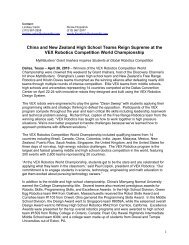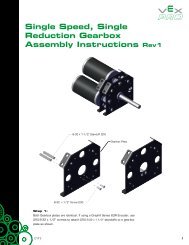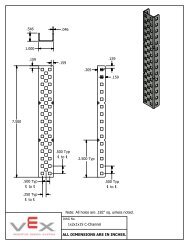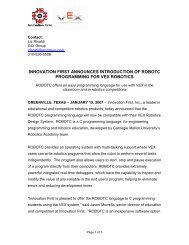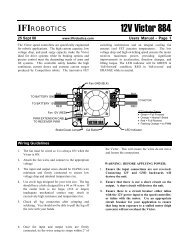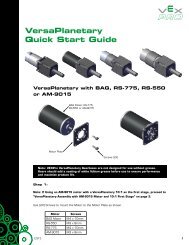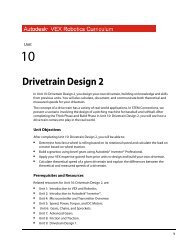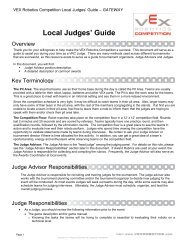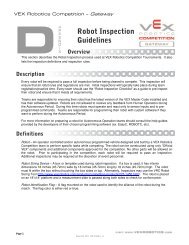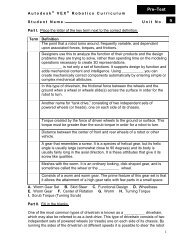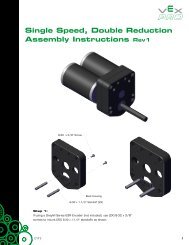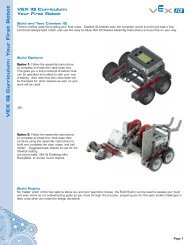Gears, Chains, and Sprockets - VEX Robotics
Gears, Chains, and Sprockets - VEX Robotics
Gears, Chains, and Sprockets - VEX Robotics
Create successful ePaper yourself
Turn your PDF publications into a flip-book with our unique Google optimized e-Paper software.
Research <strong>and</strong> ActivityIntroduction to <strong>Gears</strong>As learned in Unit 5: Speed, Power, Torque, <strong>and</strong> DC Motors, a motor can generate a set amount ofpower; that is, it can provide a specific amount of energy every second. Since there is only so muchenergy to go around, <strong>and</strong> energy is the product of torque <strong>and</strong> speed, there is an inherent trade-offbetween torque <strong>and</strong> speed.In many cases, the motor output characteristics do not match the motor application. For example, amotor that is very fast but has only a little bit of torque might not be suitable to lift a heavy load. Inthese cases, it is necessary to use gear ratios to change the outputs to a more appropriate balance oftorque <strong>and</strong> speed.About <strong>Gears</strong><strong>Gears</strong> are toothed wheels that interlock, or mesh, in order to transmit rotational motion <strong>and</strong> power(torque) efficiently. Modern gear design is a very complicated combination of material selection <strong>and</strong>its properties, which deals with the wear, strength, <strong>and</strong> durability of the design.<strong>Gears</strong> are some of the most durable <strong>and</strong> rugged mechanical parts available with efficiencies of up to98% <strong>and</strong> very long service lives, <strong>and</strong>, as a result, have significant advantages over most other drivesystems. They are an ingenious combination of the best properties of simple machines. <strong>Gears</strong> improveupon the wheel by using projections called teeth that are designed to contact the teeth of anothergear-transferring motion <strong>and</strong> force to the other gear. When gear teeth fit together in this manner theyare said to be meshed. Meshed gears transmit rotational motion from one gear to another allowingtorque to be transferred without slippage. The most common arrangement is for a gear to mesh withanother similar gear of the same type, but a gear can mesh with any device or mechanism havingcompatible teeth, such as a rack that moves in a linear direction when acted upon by a rotating gear.The gear transmitting the force or motion is called the input or drive gear <strong>and</strong> the gear connected tothe drive gear is called the output or driven gear.<strong>Gears</strong> control power transmission in three ways:1. Changing the direction through which power is transmitted.2. Changing the amount of force or torque.3. Changing the speed of rotation, typically measured in revolutions per minute (RPM).The most important mechanical feature of gears is that gears of unequal size can be combined toproduce what is called a mechanical advantage, resulting in a change of rotational speed (RPM) <strong>and</strong>torque of the second gear. This is quantified as a gear ratio.<strong>Gears</strong> are made of many different materials, but metals <strong>and</strong> plastics are the primary modern materials.Modern gear design is a complicated combination of material selection <strong>and</strong> its properties, which dealswith the wear, strength, <strong>and</strong> durability of the design. The first gears were actually made of wood <strong>and</strong>called peg wheels. Examples can still be found in use today around the world.There are many different kinds <strong>and</strong> sizes of gears, but only three major types are covered here; spur,bevel, <strong>and</strong> worm.8■Unit 6: <strong>Gears</strong>, <strong>Chains</strong>, <strong>and</strong> <strong>Sprockets</strong>



